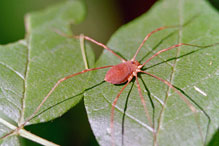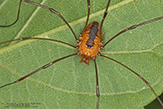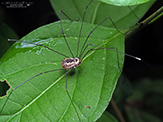Minnesota Harvestmen

Order Opiliones
Opiliones (harvestmen) is the order of arachnids that is characterized by having a body that appears to be a single segment and having generally very long legs. There are 6,491 known species worldwide, though the actual number of living species is thought to be close to 10,000. More than 100 species have been recorded in North America north of Mexico, and at least 18 species have been recorded in Minnesota.
The common name “daddy long legs” is commonly used for all harvestmen. However, that name is also often applied to crane flies and cellar spiders. The common names “brown daddy long legs” and “eastern daddy long legs” have sometimes been used to describe single species or an entire genus. However, their use has not been consistent and the names are not widely accepted. In short, harvestmen species do not have individual common names. Each species can be referred to by the common name of a higher taxonomic classification. In this case, the order Opiones has the common name “harvestman”, and that common name will be applied to all species listed here.
Virtually all of the harvestmen seen are “wanderers” of the suborder Eupnoi. The most widespread species of harvestman in the world is Phalangium opilio. It is the most common species found in disturbed habitats in Europe, Asia, and North America. In the eastern United States, the genus Leiobunum is both abundant and conspicuous. Identification of Leiobunum harvestmen to the species level is to a large part based on microscopic features. Species determination is practically impossible in the field and difficult by looking at photographs.
Recent Additions

Eastern harvestman (Leiobunum vittatum) is a common, large, easily recognized harvestman. It occurs in the United States and southern Canada from the east coast to the Great Plains. In Minnesota it is common in the wooded eastern region, uncommon in the western prairie region.
The body is golden yellow to dark reddish-brown with a large, distinct, dark figure on the upper side. In summer the figure contrasts sharply with the lighter background. As the season progresses both sexes become progressively darker. By mid-fall they can be almost black.
The legs are extremely long and slender. The patella is short and dark. There is a dark band at the outer end of the tibia. On the female the legs are light brown with contrasting dark rings. On the male the legs are dark brown and less contrasting.
Other Recent Additions

This list includes only harvestmen that have been recorded in Minnesota, but not all of the harvestmen found in Minnesota.
| Profile | Photo | Video | |||
|---|---|---|---|---|---|
Canestrini’s harvestman (Opilio canestrinii) |
|||||
golden harvestman (Leiobunum flavum) |
|||||
harvestman (Eumesosoma roeweri) |
|||||
harvestman (Gagrella splendens) |
|||||
harvestman (Leiobunum rotundum) |
|||||
harvestman (Trachyrhinus favosus) |
|||||
Nebraska harvestman (Leiobunum ventricosum) |
|||||
North American cavernicolous harvestman (Sabacon cavicolens) |
|||||
saddleback harvestman (Mitopus morio) |
|||||
small harvestman (Crosbycus dasycnemus) |
|||||
spring harvestman (Rilaena triangularis) |
|||||
spurred harvestman (Leiobunum calcar) |
|||||
trident harvestman (Oligolophus tridens) |
|||||
warty harvestman (Leiobunum verrucosum) |
Crosbycus dasycnemus (harvestman)
Eumesosoma roeweri (harvestman)
Gagrella splendens (harvestman)
Leiobunum aldrichi (Aldrich’s harvestman)
Leiobunum calcar (spurred harvestman)
Leiobunum flavum (golden harvestman)
Leiobunum rotundum (harvestman)
Leiobunum ventricosum (Nebraska harvestman)
Leiobunum verrucosum (warty harvestman)
Leiobunum vittatum (eastern harvestman)
Mitopus morio (saddleback harvestman)
Odiellus pictus (painted harvestman)
Oligolophus tridens (trident harvestman)
Opilio canestrinii (Canestrini’s harvestman)
Phalangium opilio (common harvestman)
Rilaena triangularis (spring harvestman)
Sabacon cavicolens (North American cavernicolous harvestman)
Trachyrhinus favosus (harvestman)
No Species Page Yet?
If you do not see a linked page for a species in the list at left you can still upload a photo or video or report a sighting for that species. Click on one of the buttons below and type in the common name and/or scientific name of the species in your photo, video, or sighting. A new page will be created for that species featuring your contribution.
These buttons not working for you?
Simply email us at info@MinnesotaSeasons.com.
Capitalization of Common Names
The 1997 version of Common Names of Insects and Related Organisms, published by the Entomological Society of America (ESA), contains only 9 spider species. Two of those are placed in the wrong family and four are unrecognized common names. The inadequate coverage of arachnids by the ICZN spurred the American Arachnological Society (AAS) to develop their own list, Common Names of Arachnids. While the ESA has no rule or guideline that addresses capitalization of common names, the AAS does. Capital letters should not be used unless 1) the name begins a sentence, then the first letter of the name should be capitalized; or 2) the common name begins with a proper name, and that proper name begins with a capital letter (place name or person’s last name). MinnesotaSeasons.com will adhere to the convention adopted by AAS.









